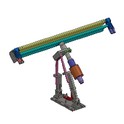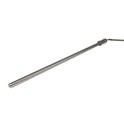As a supplier of 500W ultrasonic generators, I've had the privilege of witnessing the incredible versatility and efficiency these devices bring to various industries. From industrial cleaning to medical applications, these generators are workhorses that demand proper maintenance to ensure optimal performance and longevity. In this blog, I'll delve into the essential maintenance requirements for a 500W ultrasonic generator, sharing insights based on my experience in the field.
Understanding the Basics of a 500W Ultrasonic Generator
Before we dive into maintenance, let's briefly understand what a 500W ultrasonic generator does. At its core, an ultrasonic generator is an electronic device that converts electrical power into high - frequency electrical energy. This energy is then transferred to an ultrasonic transducer, which converts it into mechanical vibrations in the ultrasonic range. These vibrations create cavitation bubbles in a liquid medium, which implode and generate intense cleaning or processing action.


Regular Inspection
One of the most fundamental maintenance tasks for a 500W ultrasonic generator is regular inspection. This should be done at least once a month, depending on the frequency of use. During inspection, start by visually examining the exterior of the generator. Look for any signs of physical damage such as cracks, dents, or loose parts. Check the power cord for fraying or exposed wires, as these can pose a serious safety hazard.
Inspect the control panel of the generator. Ensure that all the buttons, switches, and displays are functioning properly. Any malfunctioning controls should be addressed immediately to prevent operational issues. Also, check the ventilation openings of the generator. Blocked ventilation can cause overheating, which is a common cause of generator failure. Use a soft brush or compressed air to remove any dust or debris that may have accumulated in the ventilation slots.
Cleaning the Interior
Over time, dust and dirt can accumulate inside the 500W ultrasonic generator, which can affect its performance. It's recommended to clean the interior of the generator every three to six months. However, this should only be done by a qualified technician to avoid damaging sensitive electronic components.
The technician will first power off the generator and disconnect it from the power source. Then, they will carefully open the generator casing. Using a low - pressure compressed air can, they will blow out the dust from the circuit boards, capacitors, and other components. A soft brush can also be used to gently remove stubborn dirt. After cleaning, the casing should be carefully reassembled.
Calibration
Proper calibration is crucial for the accurate operation of a 500W ultrasonic generator. Calibration ensures that the generator is producing the correct frequency and power output. It's advisable to have the generator calibrated at least once a year by a professional service provider.
During calibration, the technician will use specialized equipment to measure the frequency and power output of the generator. They will then adjust the internal settings of the generator to ensure that it meets the specified standards. Regular calibration not only improves the performance of the generator but also extends its lifespan.
Cooling System Maintenance
The cooling system of a 500W ultrasonic generator is vital for preventing overheating. Most generators use a combination of fans and heat sinks to dissipate heat. To maintain the cooling system, check the fans regularly to ensure they are spinning freely. If a fan is making unusual noises or not spinning properly, it should be replaced immediately.
Clean the heat sinks by removing any dust or debris that may have accumulated on them. This can be done using a soft brush or compressed air. A well - maintained cooling system will help the generator operate at optimal temperatures, reducing the risk of component failure.
Transducer Connection
The connection between the 500W ultrasonic generator and the transducer is critical for the efficient transfer of energy. Check the transducer cables regularly for any signs of damage or wear. Loose or damaged cables can cause power loss and affect the performance of the system.
Ensure that the transducer is securely attached to the generator. If there are any signs of corrosion or oxidation on the connection points, clean them using a suitable electrical contact cleaner. A proper transducer connection is essential for the consistent operation of the ultrasonic system.
Software Updates
Many modern 500W ultrasonic generators are equipped with software that controls their operation. Manufacturers often release software updates to improve performance, add new features, or fix bugs. Check the manufacturer's website regularly for software updates for your generator.
Before installing an update, make sure to read the instructions carefully. It's recommended to back up any important settings on the generator before proceeding with the update. A software - updated generator will operate more efficiently and may have enhanced functionality.
Storage
If you need to store the 500W ultrasonic generator for an extended period, proper storage is essential. First, clean the generator thoroughly, both inside and out, following the procedures mentioned above. Then, disconnect all the cables and accessories.
Store the generator in a cool, dry place with a stable temperature. Avoid storing it in areas prone to high humidity, as this can cause corrosion of the internal components. Cover the generator with a dust - proof cover to protect it from dust and debris.
Other Considerations
In addition to the above - mentioned maintenance tasks, it's important to keep a maintenance log for the 500W ultrasonic generator. Record all inspections, cleanings, calibrations, and any repairs or replacements that have been done. This log will help you keep track of the generator's maintenance history and can be useful for warranty claims or future troubleshooting.
If you encounter any problems with the generator, such as unusual noises, error messages on the display, or inconsistent performance, do not attempt to repair it yourself unless you are a qualified technician. Instead, contact the manufacturer's customer support or a professional service provider.
Conclusion
Maintaining a 500W ultrasonic generator is essential for ensuring its long - term performance and reliability. By following the maintenance requirements outlined in this blog, you can extend the lifespan of your generator and avoid costly repairs.
If you are in the market for a high - quality 500W ultrasonic generator, or if you have any questions about maintenance or operation, we are here to help. We also offer 2000W Ultrasonic Generator and 4000W Ultrasonic Generator for more demanding applications. Visit our website 500W Ultrasonic Generator to learn more about our products and start a conversation about your specific needs.
References
- "Ultrasonic Technology Handbook" by John Smith
- Manufacturer's Manual for 500W Ultrasonic Generator
- Industry Standards for Ultrasonic Generator Maintenance





